Today we conclude our playback of the official video of the First Golden Awards Banquet, from January 20, 1984, with the roll call of the honorees and their gathering for their group photo. This post will list all those who were present for the ceremonies as well as those who were unable to appear; I will provide very brief biographical notes for those whose interviews were not included in previous posts and for those who were unable to attend. For those whose video chats had been posted before, I will link to their interviews.
If you look closely at the group picture posted in part 1, you will see Grim Natwick who, for some reason, was not one of the honorees. Also, in the opening ceremonies, a message is read from Edith Vernick about not being able to attend; she was also not an honoree. Both were honored in 1985. In addition, Bob Clampett, who can be spotted in the backgrounds of some of the video chats, never got an award, as he passed away several months later.


Lou Appet (Louis Appet): A friend and colleague of my dad from their Fleischer days, both started in 1932 and became inbetweeners. More importantly, he became head of the Fleischer unit of the Commercial Artists and Designers Union and negotiated the first union contract in animation. For his troubles, he was briefly blacklisted after he left Fleischer until after the Disney strike, when Chuck Jones got him a job at Schlesinger’s. He was later an assistant at Disney and one of Bob Clampett’s favorite animators on the Beany and Cecil TV show. He ended his career as Local 839’s Business Representative. (He was called Lou Abbot at Fleischer due to an error he was too embarrassed to correct.)
Joe Barbera (Joseph Roland Barbera): He was not present, but certainly needs no real introduction. He began his career in 1933 at Van Beuren before joining a group of fellow artists who migrated west to MGM. He later set up Hanna-Barbera, which he seemed to stick with for some time.
Tom Baron: See my video chat with Tom here.
Bob Bentley: See my video chat with Bob here.
Dick Bickenbach (Richard Frederick Bickenbach): He started at Ub Iwerks in 1930 and became an animator and layout artist, later working for Lantz, MGM and Warner Bros. before becoming an early employee of Hanna-Barbera. There he worked in the animation department and was credited with doing the first official Yogi Bear model sheets. He was known for his strong draughtsmanship, something greatly admired by John K., who noted, “To someone of my generation who worked in an environment where almost nobody had real drawing skill, or functionality, let alone style, Dick stood out as a giant cartoonist.” (Unfortunately, Dick did not attend.)
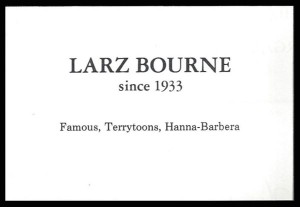 Larz Bourne: Although he indicates he started in animation in 1933, when he would been around 17 years old, the trajectory of Bourne’s career before 1947 is not readily known. However, from 1947 to 1980 he seems to have been rather prolific as a writer, storyboard artist and story editor. (He was also credited as animation director for the Tom Terrific TV show.) He worked at Famous and Terrytoons before coming out to the West Coast, where he hung his hat at Hanna-Barbera. (Larz did not attend.)
Larz Bourne: Although he indicates he started in animation in 1933, when he would been around 17 years old, the trajectory of Bourne’s career before 1947 is not readily known. However, from 1947 to 1980 he seems to have been rather prolific as a writer, storyboard artist and story editor. (He was also credited as animation director for the Tom Terrific TV show.) He worked at Famous and Terrytoons before coming out to the West Coast, where he hung his hat at Hanna-Barbera. (Larz did not attend.)
Jim Carmichael (James Dunbas Carmichael): Carmichael, who was not present, dropped out of high school to work as an artist-writer for The Los Angeles Herald. In 1930, he was hired by Disney an inbetweener, eventually becoming an animator, writer and comic strip artist. He subsequently worked at a variety of studios, including Iwerks, Warner Bros. and Hanna-Barbera. He was active in the old Screen Cartoonists Guild during its early days and was the editor of Local 839’s newsletter, The Peg-Board.
Bill Carney (William Carney): Carney began in animation at Van Beuren in 1934 as an opaquer and became an inbetweener; there he was active in the Animated Motion Picture Workers Union, the precursor of the union that organized the 1937 Fleischer strike. He then worked for Fleischer, Terrytoons, Disney, Famous, Hanna-Barbera, DePatie-Freleng and Filmation, mostly as an animator.
Chuck Couch: See my video chat with Chuck here.
Shamus Culhane (James Henry Culhane): There is little that I can say about Shamus, whose Talking Animals and Other People: The Autobiography of One of Animation’s Legendary Figures, remains one of the best animation memoirs ever published. He began at Bray in the 1920s and went on to be a top animator at Fleischer, Iwerks and Disney. At Lantz, he directed some of the best Woody Woodpecker cartoons before returning to New York to set up one of the most important early TV commercial houses, Shamus Culhane Productions; he also briefly breathed new life into the remnants of Famous Studios as its creative director.
Al Eugster (Alfred Eugster): Eugster, who was not present, began his career in 1925 as a blackener on Felix the Cat cartoons (he was featured prominently in John Canemaker’s documentary Otto Messmer and Felix the Cat). At nights, he attended Cooper Union, where he was responsible for getting such fellow students as Ed Rehberg and my dad into animation. He soon became an animator at Fleischer, Mintz and Disney. After a stint with the Army Signal Corps in World War II, he settled in New York working for Famous/Paramount (including on My Daddy the Astronaut) and most extensively at Kim and Gifford.
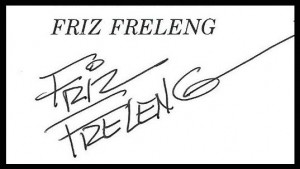 Paul Fennell: See my video chat with Paul here.
Paul Fennell: See my video chat with Paul here.
Friz Freleng (Isadore Freleng): For some reason, the banquet program did not include a list of studios he worked at, though he career is far from a mystery. He began in Kansas City in 1923, working alongside Hugh Harman and Ub Iwerks, before joining Disney in 1927. He famously worked with Harman-Ising/Leon Schlesinger, staying on to become one of the company’s top directors; he was identified with such characters as Porky Pig, Yosemite Sam, Sylvester and Tweety, and Speedy Gonzales. In 1963, he became a partner in DePatie-Freleng, which gained fame for its Pink Panther cartoons.
Ed Friedman (Edgar Friedman): Ed graduated from Polytechnic High School Class of 1931 and also went to USC for a period afterwards. He became a truck driver before briefly training as an inbetweener without pay at Goofy Gus Studios in 1933. He then went over to Ub Iwerks for two years as an inbetweener and assistant animator, then broke into animation at Mintz. However, he got his “full status as an animator on Mr. Magoo” at UPA starting in 1950. He ended his career as an animation director and director for Filmation on such shows as Flash Gordon and BraveStarr. Ed was one of the original signers of the charter for The Animation Guild in 1952, after it won a jurisdictional fight with the old Screen Cartoonists Guild to represent the major Hollywood studios.
John Gentilella (aka Johnny Gent): Johnny started in animation in 1932 at Van Beuren, probably as an opaquer, eventually becoming an inbetweener. He moved over to Fleischer and then Terrytoons, where he became an animator. At Famous, he became much admired for his work on Popeye cartoons, which he was very proud of. He later worked with Ralph Bakshi on the Spider-Man TV series, Fritz the Cat and Hey Good Lookin’. He was also animation director on the New York Institute of Technology’s ill-fated Tubby the Tuba.
Dick Hall: See my video chat with Dick here.
 Bill Hanna (William Denby Hanna): Bill joined Harman-Ising/Schlesinger in 1930, eventually moving over to MGM, where he teamed up with Joe Barbera on a series of Cat and Mouse cartoons. The two eventually became the studio’s creative directors, eventually leaving to form Hanna-Barbera, where he stayed for some time.
Bill Hanna (William Denby Hanna): Bill joined Harman-Ising/Schlesinger in 1930, eventually moving over to MGM, where he teamed up with Joe Barbera on a series of Cat and Mouse cartoons. The two eventually became the studio’s creative directors, eventually leaving to form Hanna-Barbera, where he stayed for some time.
Emery Hawkins: Emery, who was not present, began his career in 1933 at Lantz, where he quickly became an animator. He then began hopping around to various studios, including Mintz, Disney and Warner Bros, becoming one of the industry’s most admired animators. In 1950, he started working on TV commercials, including the famed Maypo spots for Hubley. In 1963, he moved to Taos, New Mexico, where he worked long distance for producers in New York, Hollywood and London, including Richard Williams, animating on Raggedy Ann and Andy and The Thief and the Cobbler.
Cal Howard (Calvin Henry Howard): The famed story artist started in animation at Disney 1930, then worked at Lantz (where he began writing) and Schlesinger, where he began directing on assignment for Ub Iwerks. He focused on writing for the rest of his career, joining Fleischer in Miami on Gulliver’s Travels, but returned to Los Angeles to work as head of MGM’s story unit. In 1947, he went to Screen Gems for its last year, then moved over to TV working in both live action and animation on both coasts.
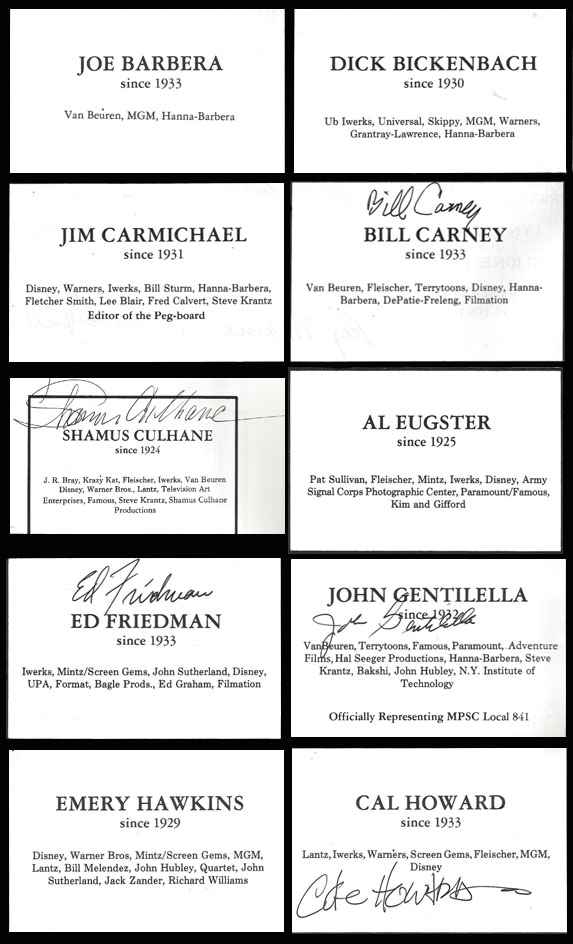
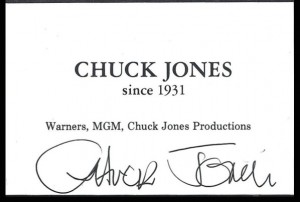 Chuck Jones (Charles Martin Jones): Chuck started his career at Schlesinger/Warner Bros. in 1931, where he was to make his greatest mark as a director of such classic cartoons as What’s Opera Doc? He occasionally worked elsewhere, including Iwerks, where he met his first wife, and Disney. He and Les Goldman partnered to make such productions as The Dot and the Line: A Romance in Lower Mathematics and How the Grinch Stole Christmas. In the mid-1990s, he produced some of the last Looney Tunes cartoons for Warner Bros..
Chuck Jones (Charles Martin Jones): Chuck started his career at Schlesinger/Warner Bros. in 1931, where he was to make his greatest mark as a director of such classic cartoons as What’s Opera Doc? He occasionally worked elsewhere, including Iwerks, where he met his first wife, and Disney. He and Les Goldman partnered to make such productions as The Dot and the Line: A Romance in Lower Mathematics and How the Grinch Stole Christmas. In the mid-1990s, he produced some of the last Looney Tunes cartoons for Warner Bros..
Jack Kinney: See my video chat with Jack here.
Eric Larson: Eric, who did not sit for an interview, was one of Disney’s so-called “Nine Old Men.” He started his career at Disney in 1933 and ended it in 1986. He animated on all the major Disney features from Snow White to The Jungle Book, and acted as consultant for such later movies as The Fox and the Hound and The Great Mouse Detective. Starting in 1973, he was actively involved in a recruiting and training program whose alumni included the likes of Brad Bird, Don Bluth, and Tim Burton, among others.
Hicks Lokey (William Hicks Lokey): Hicks began his career at the Aesop Fables Studio in 1925 as an inker and painter. He quit to return to commercial art, but came back in 1930 and eventually became an animator. He was fired following his failed attempt to form an animator’s union and went over to work in Myron Waldman’s unit at Fleischer. Although he crossed the picket line during the Fleischer strike, his contract was not renewed because of his union sympathies. He moved to Los Angeles, first working for Lantz and then Disney. His proudest accomplishment was animating on the “Pink Elephants on Parade” sequence in Dumbo. He crossed the picket line during the Disney strike, mainly because he was due to be called up for active duty in the Army (he was a reserve officer). After the war, he returned to Disney, followed by a stay at Paul Fennell. He ended his career at Hanna-Barbera.
Ed Love: See my video chat with Ed here.
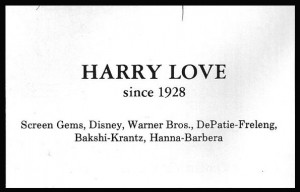 Harry Love: Harry, who did not sit for an interview, began his career at Mintz in 1929, when it was in New York. He worked variously as an animator, writer and production manager. He worked for Disney, Warner Bros., DePatie-Freleng (Pink Panther cartoons), Ralph Bakshi (Heavy Traffic) and Hanna-Barbera (Yogi Bear and the Magical Flight of the Spruce Goose).
Harry Love: Harry, who did not sit for an interview, began his career at Mintz in 1929, when it was in New York. He worked variously as an animator, writer and production manager. He worked for Disney, Warner Bros., DePatie-Freleng (Pink Panther cartoons), Ralph Bakshi (Heavy Traffic) and Hanna-Barbera (Yogi Bear and the Magical Flight of the Spruce Goose).
Jack Ozark: See my video chat with Jack here.
Ray Patterson (Raymond Shepard Patterson): Patterson, who did not sit for an interview, began at Mintz in 1930 as an inker. Around 1939, he became an animator at Disney, working on Dumbo, Fantasia and some Pluto shorts. He and his brother Don (also an animator) were involved in the 1941 Disney strike, and he was subsequently laid off. He then worked at Screen Gems and more permanently at MGM, in the Hanna-Barbera unit. In 1946, he spent time in the United Kingdom teaching Dave Hand’s staff at GB American-style animation. In 1954, he co-founded Grantray-Lawrence, which made TV commercials and TV series such as Spider-Man. He ended his career at Hanna-Barbera, where he became a Vice President.
Val Vreeland Paul (Valentine Vreeland Paul): Val, the only female honoree, began her career in ink, paint and checking at Disney’s in 1931, where she also became a department head. Over the years, she also worked for Format, Bakshi, Filmation and Hanna-Barbera. Her credits include: Fat Albert and the Cosby Kids, Hey Good Lookin’, The New Adventures of Mighty Mouse, Flash Gordon and The Prince and the Pauper.
Ed Rehberg: See my video chat with Ed here.
Virgil Ross (Virgil Walter Ross): Virgil began his career in 1930 at Mintz. He later worked for Iwerks and Lantz (where he began to animate). In 1935, he joined Schlesinger/Warner Bros., staying for about 30 years and doing his most famous work, including animating Bugs Bunny in his first appearance in A Wild Hare. The last part of his career was spent mostly working on TV shows at Hanna-Barbera, Filmation and DePatie Freleng, as well as for Bakshi’s Hey Good Lookin’. His later credits include Flash Gordon and The Smurfs.
Ben Shenkman: Ben, who did not sit for an interview, began at Fleischer in 1930, presumably as an opaquer, worked as an assistant animator and animator until the early 1980s. He also worked for Warner Bros., Jay Ward, Hanna-Barbera, Filmation, DePatie-Freleng and Bakshi. His credits include Archie’s Funhouse, Star Trek: The Animated Series, Coonskin, Wizards and Hey Good Lookin’.
Larry Silverman: See my video chat with Larry here.
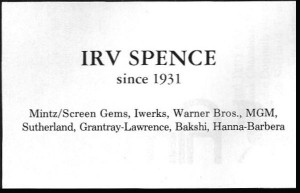 Irv Spence (Irven LeRoy Spence): Irv, who did not sit for an interview, began his career in 1931 at Mintz and then animated on the Flip the Frog cartoons for Iwerks. In 1936, he joined Schlesinger as part of Tex Avery’s unit. He followed Avery to MGM, but soon became attached to the Hanna-Barbera and animated on Tom and Jerry, including the Oscar-winning The Yankee Doodle Mouse. He eventually joined the Hanna-Barbera Studio where and worked on The Flintstones and Jonny Quest. He also animated for Chuck Jones, DePatie-Freleng and Bakshi (Coonskin and Wizards). His last credit was on Tom and Jerry: The Movie.
Irv Spence (Irven LeRoy Spence): Irv, who did not sit for an interview, began his career in 1931 at Mintz and then animated on the Flip the Frog cartoons for Iwerks. In 1936, he joined Schlesinger as part of Tex Avery’s unit. He followed Avery to MGM, but soon became attached to the Hanna-Barbera and animated on Tom and Jerry, including the Oscar-winning The Yankee Doodle Mouse. He eventually joined the Hanna-Barbera Studio where and worked on The Flintstones and Jonny Quest. He also animated for Chuck Jones, DePatie-Freleng and Bakshi (Coonskin and Wizards). His last credit was on Tom and Jerry: The Movie.
Nick Tafuri (Nicholas Tafuri): Nick, who was not present, began his career in 1932 at Fleischer, where he became an animator in Myron Waldman’s unit. His credits include Aladdin and His Wonderful Lamp, Gulliver’s Travels and Mr. Bug Goes to Town. He remained with the company when it became Famous Studio until it closed in 1967. He later worked for Bakshi on Spider-Man and Fritz the Cat, as well as for Joe Oriolo and Howard Beckerman.
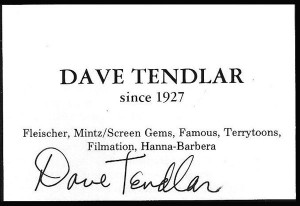 Dave Tendlar (David Benjamin Tendlar): Dave started in animation in 1927 at Fleischer working on Ko-Ko the Clown cartoons as a blackener. When sound came in he went to Harrison-Gould (Krazy Kat Studio) and John McCrory, where he became an animator doing commercials and experimental work for early television. He returned to Fleischer and eventually became a head animator, and stayed on when it became Famous Studios. His credits there include Aladdin and His Wonderful Lamp, Gulliver’s Travels and Mr. Bug Goes to Town. He also worked at Terrytoons before moving to Los Angeles, where he did work for Filmation, Bakshi and Hanna-Barbera. His later credits include Charlotte’s Web and Heavy Traffic.
Dave Tendlar (David Benjamin Tendlar): Dave started in animation in 1927 at Fleischer working on Ko-Ko the Clown cartoons as a blackener. When sound came in he went to Harrison-Gould (Krazy Kat Studio) and John McCrory, where he became an animator doing commercials and experimental work for early television. He returned to Fleischer and eventually became a head animator, and stayed on when it became Famous Studios. His credits there include Aladdin and His Wonderful Lamp, Gulliver’s Travels and Mr. Bug Goes to Town. He also worked at Terrytoons before moving to Los Angeles, where he did work for Filmation, Bakshi and Hanna-Barbera. His later credits include Charlotte’s Web and Heavy Traffic.
Carl Urbano: Carl began his career at Winkler’s (i.e., Mintz) in 1931, then went over to Van Beuren before leaving for the West Coast and Harman-Ising (animating on Merbabies). He then moved over to MGM. During the war, he seems to have spent some time in Mexico. He spent considerable working as a director for Hugh Harman, John Sutherland (Destination Earth and Rhapsody of Steel) and Hanna-Barbera (where he mostly worked on their TV shows, including The Smurfs and The Addams Family).
Carlo Vinci: See my video chat with Carlo here. “I thought I was forgotten.”
Bernie Wolf (Bernard Wolf): Bernie, who did not sit for an interview, began his career as an inker at the Krazy Kat Studios in 1927 before joining Fleischer, where he became an animator on Swing, You Sinners. He later moved to the West Coast to work for Iwerks (Willie Whopper cartoons) and later Disney. There he animated on Pinocchio, Fantasia and Dumbo. He left after the 1941 strike though he did not go out on strike. He worked briefly at MGM before being drafted and assigned to the First Motion Picture Unit. After the war, he briefly worked for Rudy Ising before forming his own company, Animedia, which produced commercials, costume designs for Walt Disney World and animation for Sesame Street. He later worked for Hanna-Barbera on various shows as a producer and animation director, including Jonny Quest.
Rudy Zamora: See my video chat with Rudy here.
 Jack Zander (Arthur Jack Zander): Jack broke into the animation industry by bluffing his way into a job with Zane Grey’s son Romer and was then able to teach himself how to animate. He then landed at Harman-Ising/Schlesinger before going to New York to work for Van Beuren and Terrytoons. He returned to the West Coast and animated for MGM, including some early Tom and Jerry cartoons (he was apparently the original animator for Jerry). During the war, he served in the Army Signal Corps and then returned to New York. There he ran two of the city’s most important commercial houses: Pelican Films and Zander’s Animation Parlour. He made the Harry and Bert spots for Piels Beer and the TV special, Gnomes. He served several terms as President of the Screen Cartoonists Guild in Los Angeles and was also known for giving work to blacklisted artists during the McCarthy period.
Jack Zander (Arthur Jack Zander): Jack broke into the animation industry by bluffing his way into a job with Zane Grey’s son Romer and was then able to teach himself how to animate. He then landed at Harman-Ising/Schlesinger before going to New York to work for Van Beuren and Terrytoons. He returned to the West Coast and animated for MGM, including some early Tom and Jerry cartoons (he was apparently the original animator for Jerry). During the war, he served in the Army Signal Corps and then returned to New York. There he ran two of the city’s most important commercial houses: Pelican Films and Zander’s Animation Parlour. He made the Harry and Bert spots for Piels Beer and the TV special, Gnomes. He served several terms as President of the Screen Cartoonists Guild in Los Angeles and was also known for giving work to blacklisted artists during the McCarthy period.
Lou Zukor (Louis Zukor): Lou, who did not sit for an interview, began his career working for Romer Grey, before moving over to Mintz, Iwerks and Lantz. He then was recruited by Fleischer to work in Miami, where he animated on Gulliver’s Travels and Mr. Bug Goes to Town, staying stayed on through the transition to Famous Studios. Later he worked mostly on TV shows, including producing and animating on the Q.T. Hush series for Animation Associates. For Filmation, he was a director/animation director/animator on a number of shows, including Blackstar and He-Man and the Masters of the Universe. He’s the brother of Morey Zukor.
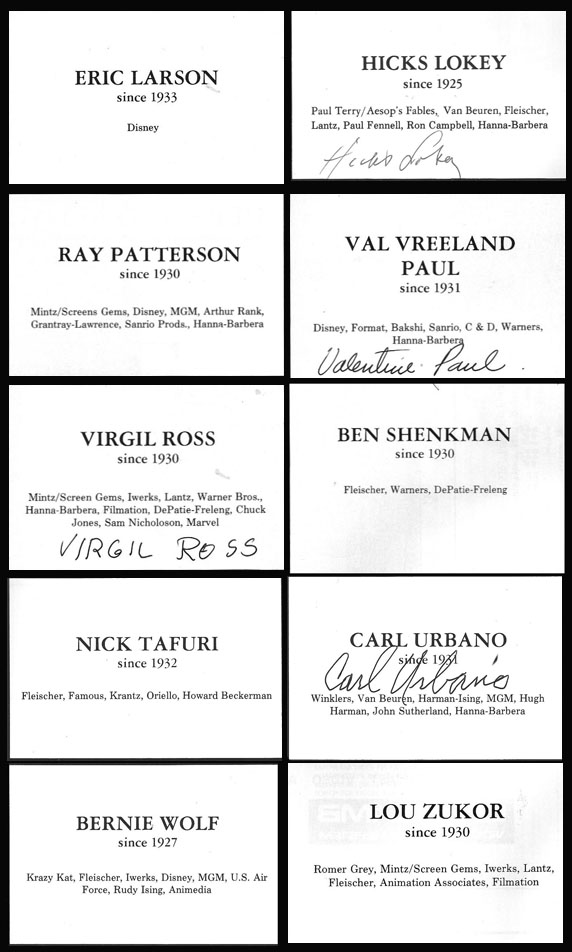


 Harvey Deneroff is an independent film and animation historian based in Los Angeles specializing in labor history. The founder and past president of the Society for Animation Studies, he was also the first editor of Animation Magazine and AWN.com. Harvey also blogs at deneroff.com/blog.
Harvey Deneroff is an independent film and animation historian based in Los Angeles specializing in labor history. The founder and past president of the Society for Animation Studies, he was also the first editor of Animation Magazine and AWN.com. Harvey also blogs at deneroff.com/blog.




































































For what it’s worth, Larz (sometimes spelled Lars) Bourne is listed in the 1940 census as living at 2400 Northwest 16th Street Road in Miami, Dade County, Florida (as Lars Bourne), and his profession is listed as “Artist-Cartoon Studio” The same document states that he was living in Tennessee (his native state) in 1935, when he would have been 19. His income in the previous year (1939), for which he worked 52 weeks, was $1,641.
His residence, I should note, is less than a mile from the Fleischer studio at 1701 NW 30th Avenue, which to me strongly suggests that as of 1939-1940, he was working at the Fleischer studio. I have not yet located his draft card, which might indicate where he was working as of 1941-1942.
This is amazing stuff! It’s so nice that all these people could have been honored. In future weeks, I’m sure we’ll get a taste of each animator’s most interesting work, once it is realized just what each animator had done on which films. I was always under the impression that Bill Hanna did a stint at Paul Terry’s studio, but I guess I was wrong. Chuck Jones sounds positively youthful here!
I did some more digging. The only three nuggets I could find were:
(1) Thad K. had mentioned in a March, 2015 post that Larz Bourne had done some promotional drawings for the Paramount Sales News in September, 1942, including one that was signed.
(2) For some odd reason, ancestry.com doesn’t have any Lars/Larz Bourne draft registration card, though I did find an indication that between June, 1943 and October, 1945, Bourne was in the service. No details as to which branch or where, unfortunately.
(3) While I didn’t find the actual obit from the NYT, it was cited for the proposition that Bourne had started work at Fleischer “in Miami” in 1937. To the best of my knowledge, though, the Miami studio didn’t open until October of 1938, so I don’t know how much you can put into the Times’ statement.
The conclusion I reach, from the scraps I’ve found, is that it’s highly likely that Bourne worked for Fleischer in Miami starting no later than 1939 (as the April, 1940 census report notes), and he was apparently working for them at least through the fall of 1942 (based on the publicity drawings he did), before going into the service between June, 1943 and October, 1945. He was in Tennessee in 1935 (again, the 1940 census). This leaves gaps of 1935-1939, late 1942-early 1943, and late 1945-1947 in his CV.
“Bernie Wolf […] became an animator on Swing, You Sinners.”
Evidence? I’ve seen no sign that Berny became an animator before 1931.
You’re probably right, as Shamus Culhane noted in Talking Animals and Other People, that “Bernie Wolfe had become an animator a few months after Swing, You Sinners, having moved up to fill the place of one of the veteran animators who had gone west.”
Two comments:
Eric is correct, and the date on Larz Bourne’s card is incorrect. According to Larz himself (in an interview with Will Friedwald), he started at the Fleischer studio when it first opened in Miami as an opaquer, no earlier than 1938. (He was originally from Tennessee.)
Zachary, after the Krazy Kat studio moved west, Berny Wolf went to Fleischer’s and quickly became a full animator. Not sure what his first cartoon was, but it was certainly before 1931.
“[Irv Spence] followed Avery to MGM (…)”
Irv Spence was already at MGM in late 1938 working on the Captain and the Kids shorts, so if anything, he was first of the two to get there!
Out of curiosity, what segments did Bernie Wolf animated for “Sesame Street”?